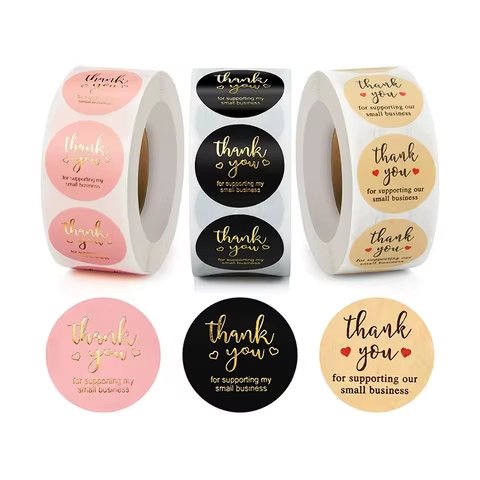Self-adhesive labels—commonly known as stickers—are adhesive-backed printing products widely used in daily life and various industries. With customizable designs, vivid printing options, and strong applicability, they have become an essential product in the label printing industry.
Stickers can be applied to a wide range of surfaces, including stationery, tableware, furniture, appliances, electronics, vehicles, mobile phones, game consoles, industrial signs, and advertising labels. They can be freely pasted, are typically disposable, and come in numerous material types and finishes.
How to Choose the Right Self-Adhesive Label Material
Choosing the correct label material ensures proper adhesion, durability, and packaging suitability. Below are the key factors to consider.
1. Cylindrical Bottles (Especially < 30mm Diameter)
Small-diameter round bottles require high-flexibility adhesive materials to avoid wrinkling, lifting, or detachment.
Recommended: Soft PET, PE, PP, or conformable films.
2. Labels That Are Too Large or Too Small
Extreme label sizes may cause application issues.
✔ Conduct practical adhesion tests before mass production.
3. Irregular or Spherical Surfaces
Labels on curved or uneven surfaces require special material considerations:
- Material softness
- Thickness
- Adhesive strength & type
- Surface conformability
4. Rough or Uneven Surfaces (e.g., Corrugated Boxes)
Rough surfaces reduce adhesive contact.
Even the varnish coating on corrugated boards affects adhesion.
Solution: Use strong-adhesion hot-melt adhesives or rubber-based adhesives.

5. Automatic Labeling Machine Compatibility
For machine-applied labels:
✔ Conduct labeling machine testing
✔ Ensure correct release liner thickness, stiffness, and die-cut accuracy
6. Temperature Considerations (Especially During Export)
Even if stored at room temperature, labels may experience:
- High-temperature shipping environments
- Outdoor heat exposure
- Heat during product usage
Choose adhesives with temperature resistance to avoid falling off.
7. High Water or Oil Environments
Moisture, oil, condensation, and wet surfaces significantly impact adhesion.
Use: Waterproof labels, oil-resistant adhesives, PP/PET films, freezer-grade adhesives.
8. Plasticizer Migration on Soft PVC Surfaces
Soft PVC releases plasticizers that can penetrate labels and weaken adhesion.
Solution: Choose plasticizer-resistant adhesives.
Custom Self-Adhesive Sticker Printing Methods
Self-adhesive label printing varies across regions and production needs. Here are the primary printing methods used in the global sticker industry.
1. Flexographic Printing (Mainstream Method Worldwide)
Flexo printing is the most typical and widely adopted method for self-adhesive sticker production.
Why Flexography Is Popular:
- Environmentally friendly, uses water-based or UV inks
- High-speed roll-to-roll production
- Circular die-cutting for precise shaping
- Stable quality & suitable for large quantities
- Supports special effects (hot stamping, varnish, lamination)
Commonly used for:
✔ Food labels
✔ Beverage labels
✔ Daily chemical labels
✔ Pharmaceutical labels
2. Combination: Semi-Letterpress + Semi-Flexographic (Mainly Europe)
This hybrid process integrates flexo and letterpress printing.
Features
- 50% letterpress usage in Europe
- Most equipment uses UV inks
- Roll-to-roll processing
- Suitable for multi-process labels requiring precision
Common applications:
✔ Cosmetic labels
✔ High-end product labels
✔ Small-batch specialty labels
3. Letterpress/Embossed Printing (Mainly Asia-Pacific & Developing Regions)
In many developing countries, embossed letterpress printing remains common.
Features
- Lower equipment cost
- Many producers still use resin inks instead of UV inks
- High percentage of manual production
- Flat die-cutting is mainstream
Although less advanced, it remains widely used for:
✔ Low-cost stickers
✔ Mass-market labels
✔ Simple packaging labels
Choosing the Right Sticker Material & Printing Process Matters
Selecting the appropriate self-adhesive label material and printing method is crucial to ensuring adhesion performance, environmental suitability, aesthetics, and production efficiency. Considering application environments, container shapes, and printing requirements will greatly improve label durability and brand presentation.


